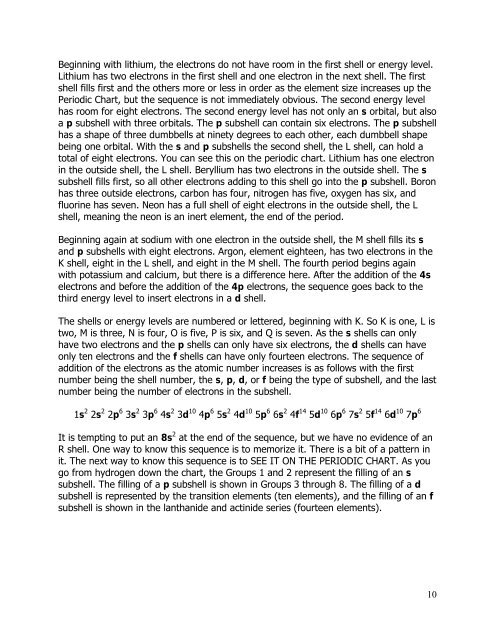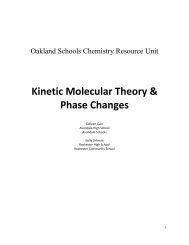Electrons and Quantum Mechanics - Oakland Schools
Electrons and Quantum Mechanics - Oakland Schools
Electrons and Quantum Mechanics - Oakland Schools
You also want an ePaper? Increase the reach of your titles
YUMPU automatically turns print PDFs into web optimized ePapers that Google loves.
Beginning with lithium, the electrons do not have room in the first shell or energy level.<br />
Lithium has two electrons in the first shell <strong>and</strong> one electron in the next shell. The first<br />
shell fills first <strong>and</strong> the others more or less in order as the element size increases up the<br />
Periodic Chart, but the sequence is not immediately obvious. The second energy level<br />
has room for eight electrons. The second energy level has not only an s orbital, but also<br />
a p subshell with three orbitals. The p subshell can contain six electrons. The p subshell<br />
has a shape of three dumbbells at ninety degrees to each other, each dumbbell shape<br />
being one orbital. With the s <strong>and</strong> p subshells the second shell, the L shell, can hold a<br />
total of eight electrons. You can see this on the periodic chart. Lithium has one electron<br />
in the outside shell, the L shell. Beryllium has two electrons in the outside shell. The s<br />
subshell fills first, so all other electrons adding to this shell go into the p subshell. Boron<br />
has three outside electrons, carbon has four, nitrogen has five, oxygen has six, <strong>and</strong><br />
fluorine has seven. Neon has a full shell of eight electrons in the outside shell, the L<br />
shell, meaning the neon is an inert element, the end of the period.<br />
Beginning again at sodium with one electron in the outside shell, the M shell fills its s<br />
<strong>and</strong> p subshells with eight electrons. Argon, element eighteen, has two electrons in the<br />
K shell, eight in the L shell, <strong>and</strong> eight in the M shell. The fourth period begins again<br />
with potassium <strong>and</strong> calcium, but there is a difference here. After the addition of the 4s<br />
electrons <strong>and</strong> before the addition of the 4p electrons, the sequence goes back to the<br />
third energy level to insert electrons in a d shell.<br />
The shells or energy levels are numbered or lettered, beginning with K. So K is one, L is<br />
two, M is three, N is four, O is five, P is six, <strong>and</strong> Q is seven. As the s shells can only<br />
have two electrons <strong>and</strong> the p shells can only have six electrons, the d shells can have<br />
only ten electrons <strong>and</strong> the f shells can have only fourteen electrons. The sequence of<br />
addition of the electrons as the atomic number increases is as follows with the first<br />
number being the shell number, the s, p, d, or f being the type of subshell, <strong>and</strong> the last<br />
number being the number of electrons in the subshell.<br />
1s 2 2s 2 2p 6 3s 2 3p 6 4s 2 3d 10 4p 6 5s 2 4d 10 5p 6 6s 2 4f 14 5d 10 6p 6 7s 2 5f 14 6d 10 7p 6<br />
It is tempting to put an 8s 2 at the end of the sequence, but we have no evidence of an<br />
R shell. One way to know this sequence is to memorize it. There is a bit of a pattern in<br />
it. The next way to know this sequence is to SEE IT ON THE PERIODIC CHART. As you<br />
go from hydrogen down the chart, the Groups 1 <strong>and</strong> 2 represent the filling of an s<br />
subshell. The filling of a p subshell is shown in Groups 3 through 8. The filling of a d<br />
subshell is represented by the transition elements (ten elements), <strong>and</strong> the filling of an f<br />
subshell is shown in the lanthanide <strong>and</strong> actinide series (fourteen elements).<br />
10
















